The Bulova Lunar Pilot chronograph is a watch that has plagued my mind for such a long time, I figured it was time to get my thoughts down and share them with the community. Close to a year ago, I pulled the trigger and purchased it from a small family jeweler selling the watch well below MSRP. It had been such a long time since the watch was officially announced that I was floored to finally get it (Bulova took forever to start shipping these after making the official announcement). Shortly after, the honeymoon phase died down, the watch was sold, and now, it’s on my mind again (the newer, all-black model) so I’m taking some time evaluate what Bulova is offering here. For now though, let’s get into the specifics of the first generation Bulova Lunar Pilot Chronograph.
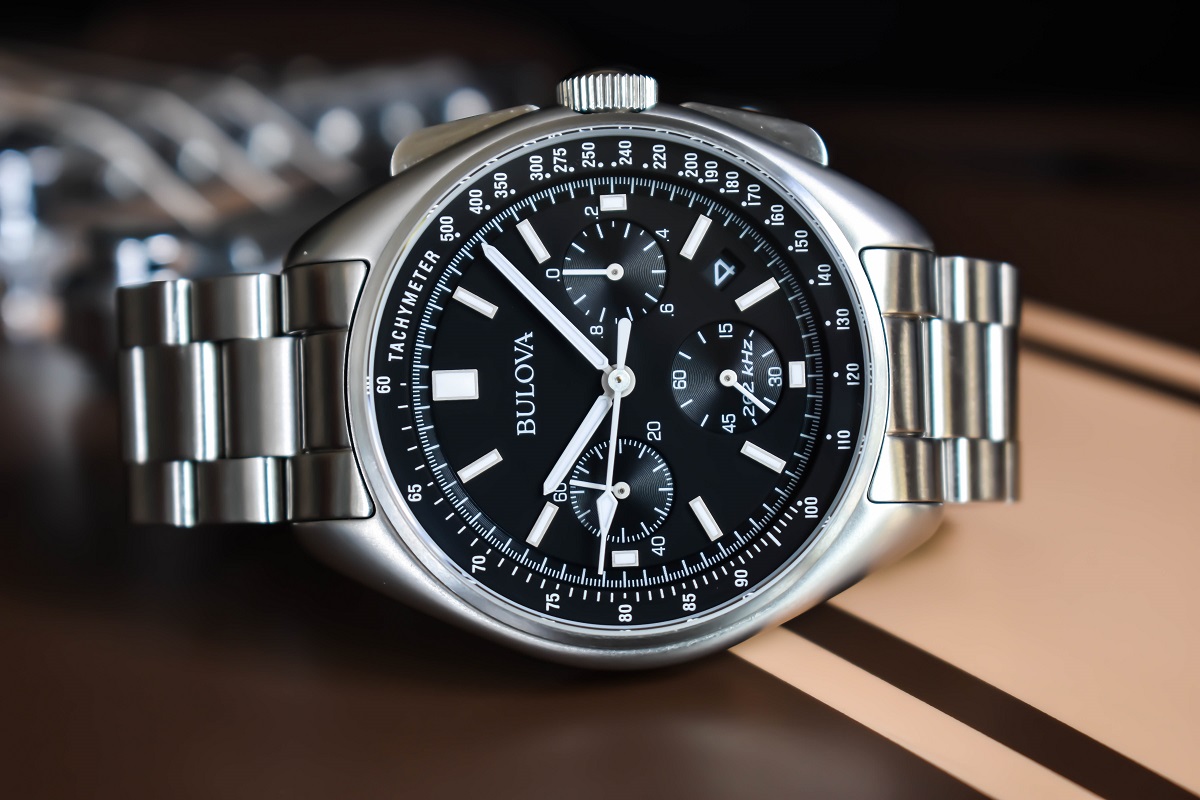
There’s something really special about a chunky, black dial sports chronograph on a steel bracelet. Really, it’s practically everything you need but when you throw something like Bulova’s 262kHz quartz caliber into the mix, the package just gets better. That’s mostly what attracted me initially and it really takes the whole grab-and-go quartz concept to a new level. But there were still some things that didn’t sit well with me (minor things) which lead me to sell the watch. I guess we should start by getting that all out in the open.
The Case
At 45mm wide, a great deal of folks were doubtful when the ‘Bulova Moon Watch’ was first announced. It just seems unnecessarily large but like all watches, you can never really tell if it’ll work for you until you get it on wrist. The case itself is 316L stainless steel with a soft, almost bead blasted effect that results in somewhat of a muted tone. Annoyingly, the bracelet is finished differently and was the only option that made the watch wearable for me… but we’ll get to that later. The case is also around 13.5mm thick and 52mm lug-to-lug, which is probably still the biggest deal breaker for watch enthusiasts considering the Lunar Pilot.
Once again, while that 52mm measurement might seem daunting, there is a fine degree of fluidity existing between lugs and the bracelet. This allows for a surprisingly balanced fit and I maintained that specific configuration for most of my time with the watch. Over at 2 and 4 o’clock, we get a fun set of really satisfying and truly unique chronograph pushers with a simple push/pull signed crown in between. Water resistance is 50m and the watch is fitted with a simple screw-down caseback. Looking at the case from the side, we really get a sense of how playful the case architecture is, with its large cylindrical bezel and a tall box sapphire crystal.
The Dial
In my eyes this is the part of the watch that’s executed perfectly. The dial itself is deep black and extends well into the case’s extremities. In other words, Bulova made great use of the space provided by a 45mm case. As a result, legibility is excellent and so are the proportions. Just look at the hand length pictured above. Each one extends adequately to its corresponding track, whether it’s the small white batons in the sub-dials or the primary hour and minute hands. There’s also quite a bit of depth on display here with various layers serving to aid the display of information.
From the outermost tachymeter ring, we step down to a grooved, fully graduated layer with a 1/5 second scale and larger ticks for the minutes. Closer to center we have our main dial display, which is raised and features an assortment of lumed rectangular indices for the hours. Finally, the three sub-dials—all adequately spaced apart—exist on what appears to be the same layer as the minutes track just under the tachymeter scale. There’s a simple date window at 4:30 and the sub-dials at 3, 6, and 9 o’clock handle the 1/10th second counter, running seconds display, and minute totalizer respectively. It’s all big, really easy to read, and text is kept to a minimum—no complaints here.
The Bracelet
This version of the Bulova Lunar Pilot Chronograph comes with a brushed (ugh) 20mm stainless steel bracelet that is just exceptionally handsome. It’s hefty, doesn’t add excessive weight, and I just love how seamless it looks with the butterfly clasp closed. I just for the life of me can’t make sense of difference in finishing. This is one of the nicest bracelets you can get in this price range and it’s a shame that it looks like some kind of bad aftermarket mix-up. And for me, this watch didn’t play well on other straps, which really did accent the 45mm case size in a bad way. Swapping wasn’t an option and now that I think of it, I wonder if it would have been worth it to just bead blast the bracelet somehow.
Case
• 45mm x 52mm x 13.5mm – strong architecture and fluidity makes the larger dimensions very wearable
Dial
• Deep black with excellent proportions and depth – very legible and visually balanced
Strap
• 20mm bracelet is brushed and features no taper, which isn’t to my taste – other strap combos can be hard (also available in leather)
Movement
• 262 Khz high performance quartz movement – incredible accuracy at -/+ 10 seconds per year
There is also no taper, which looks hilarious now that I’m reviewing the photos again. All those issues aside, while the bracelet might seem like the root of all my issues with the watch, it is in fact very impressive. It’s my understanding that there are some differences in case architecture between this version and the one that comes with the faux carbon fiber looking strap. But unless you’re really into strap swapping, I think this is the version to get if you don’t have an issue with the unmatched bracelet finishing.
The Movement
This is by far, the star of the show and enough of a reason to even have the watch in the collection. In fact, I think it’s what I miss the most about the Bulova Lunar Pilot and the absurd performance is really the best feature. Inside, the 262 kHz quartz movement is accurate to about 10 seconds per year and operates at a higher frequency than most common quartz movements. Bulova also refers to this as “High Performance Quartz,” a topic we discussed in more detail on the podcast here. It’s also cool to notice that the running seconds operate with a kind of pseudo sweep, as the hand “glides” along beating at about 2 times per second.
“I still think Bulova has created something very special here. I hope to see more variations in the future and maybe, just maybe, a 40mm version.”
Conclusion
It’s hard for me to say where I really stand with the Bulova Lunar Pilot Chronograph at this point. I know it’s a hell of a watch, but some things were just unforgivable. Currently, I’m considering the 2017 update, which features a black ion plated case finish, traditional Bulova wordmark, and no-date dial configuration. Many have claimed that the black case results in a more compact look, but that’s something I’d definitely have to see in person. As it stands, it looks like I might give it a shot because I still think Bulova has created something very special here. I hope to see more variations in the future and maybe, just maybe, a 40mm version. Hey now that we have a stainless steel Pepsi bezel Rolex GMT Master II, anything can happen, right?
Price for the Bulova Lunar Pilot Chronograph on the steel bracelet is $675, however the actual price is hundreds of bucks lower than that on Amazon for both the Chronograph with the Bracelet* and the version with the leather strap*- so be sure to check them out.
Learn more by visiting Bulova’s official site and check out our Bulova Watches history and resource page.

Co-Founder & Senior Editor
Michael Peñate is an American writer, photographer, and podcaster based in Seattle, Washington. His work typically focuses on the passage of time and the tools we use to connect with that very journey. From aviation to music and travel, his interests span a multitude of disciplines that often intersect with the world of watches – and the obsessive culture behind collecting them.
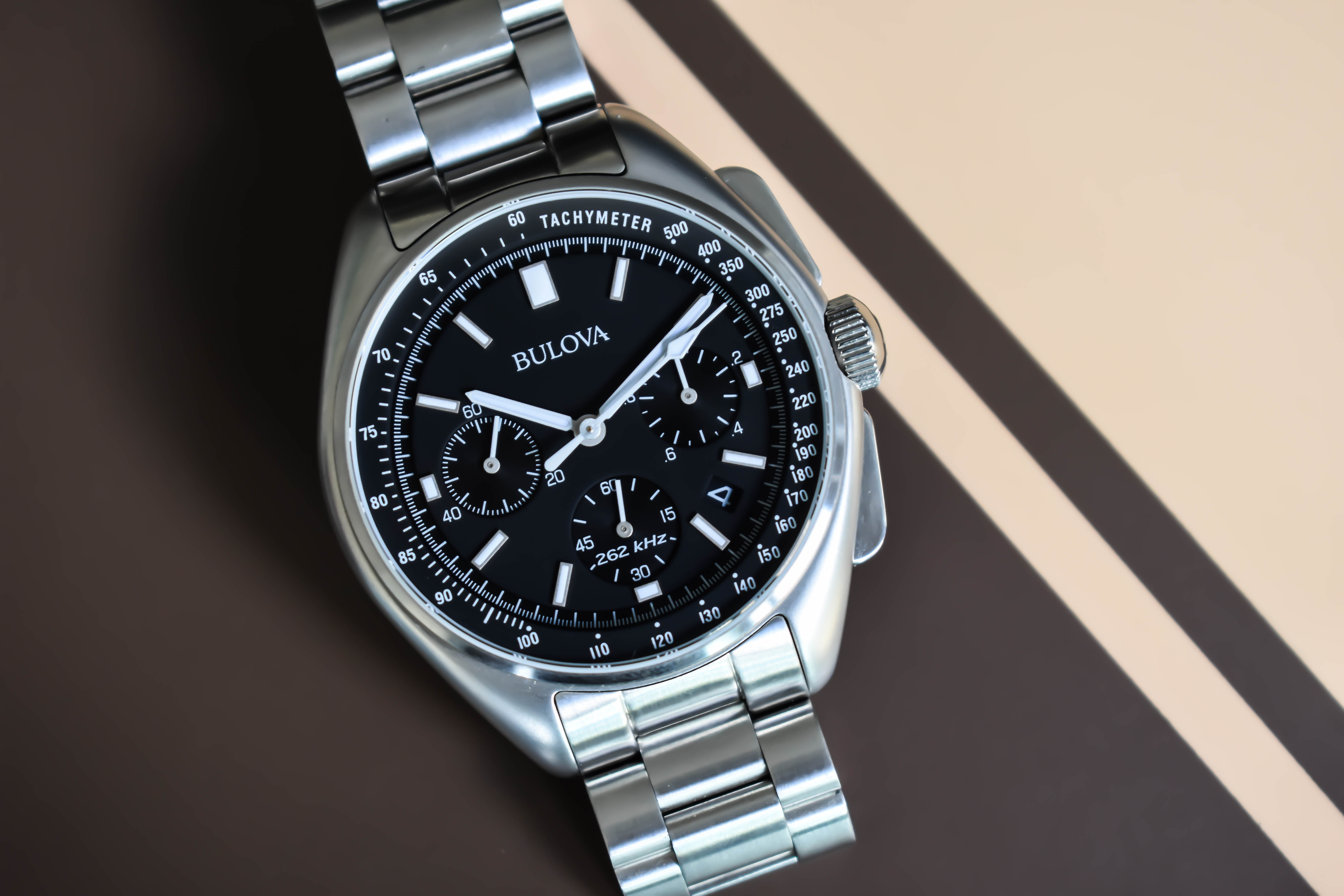
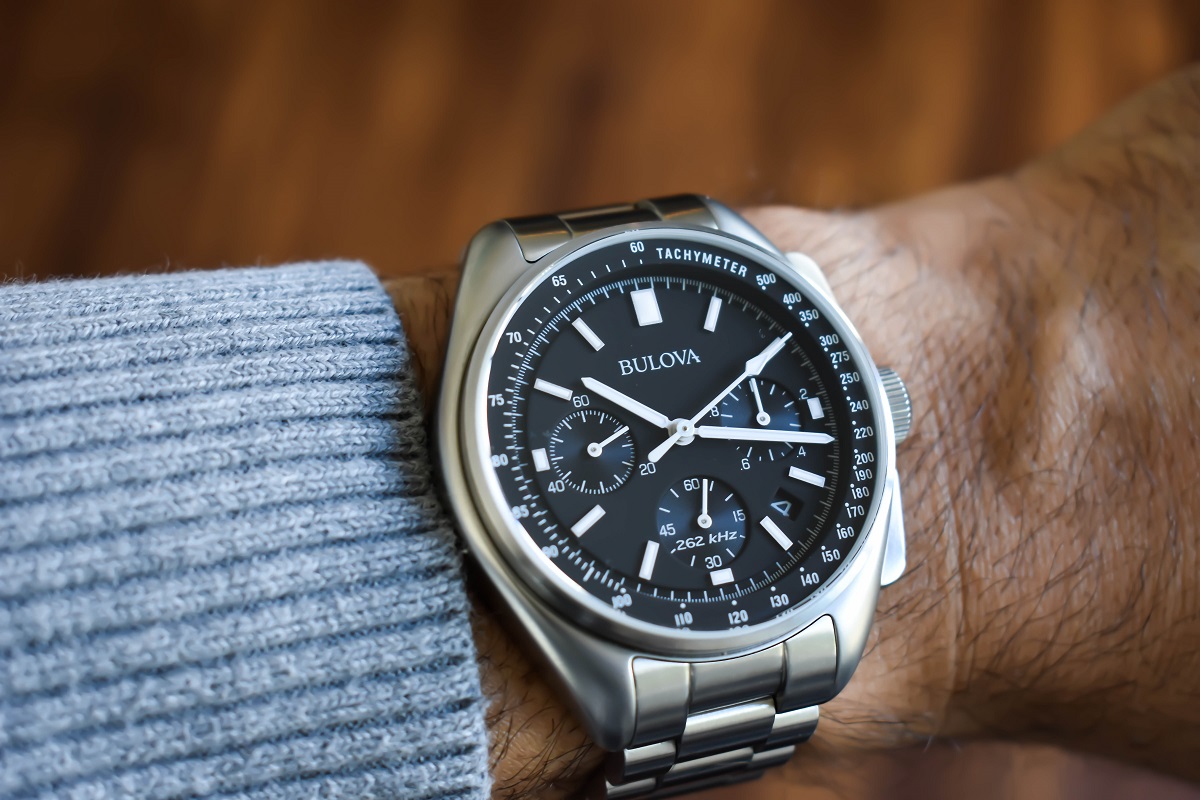
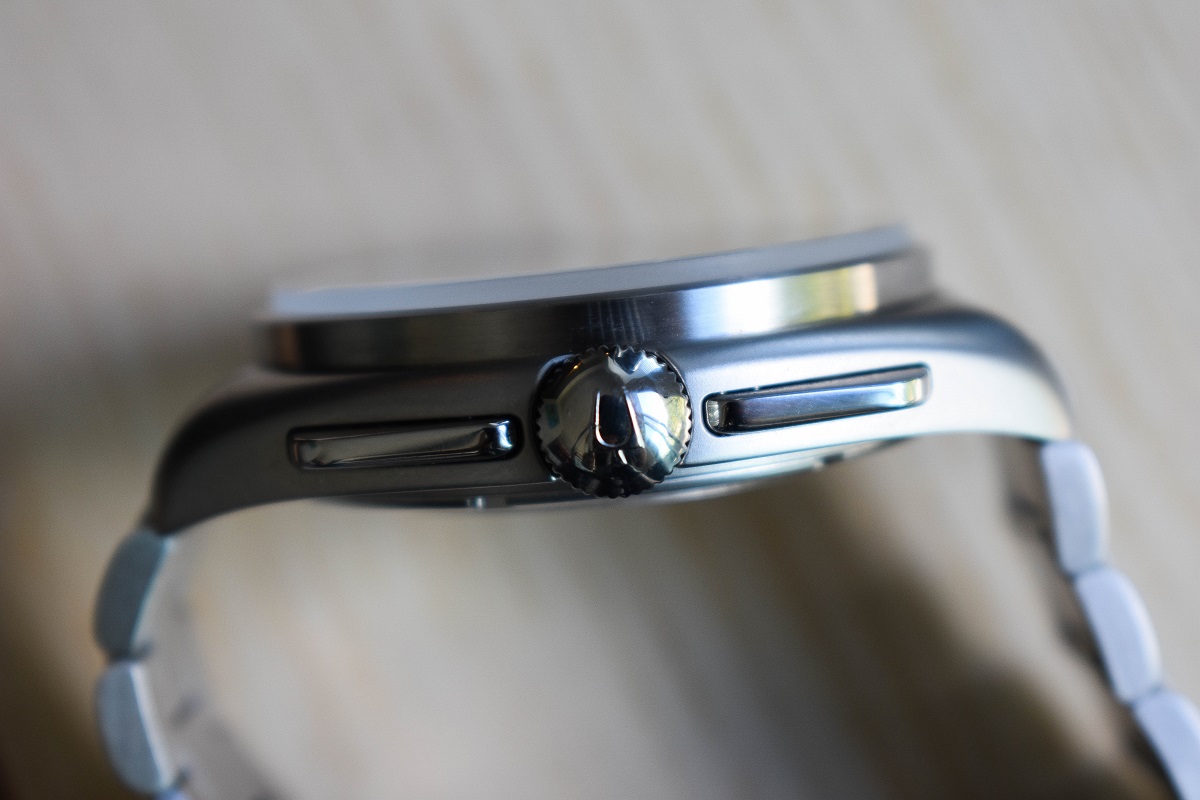
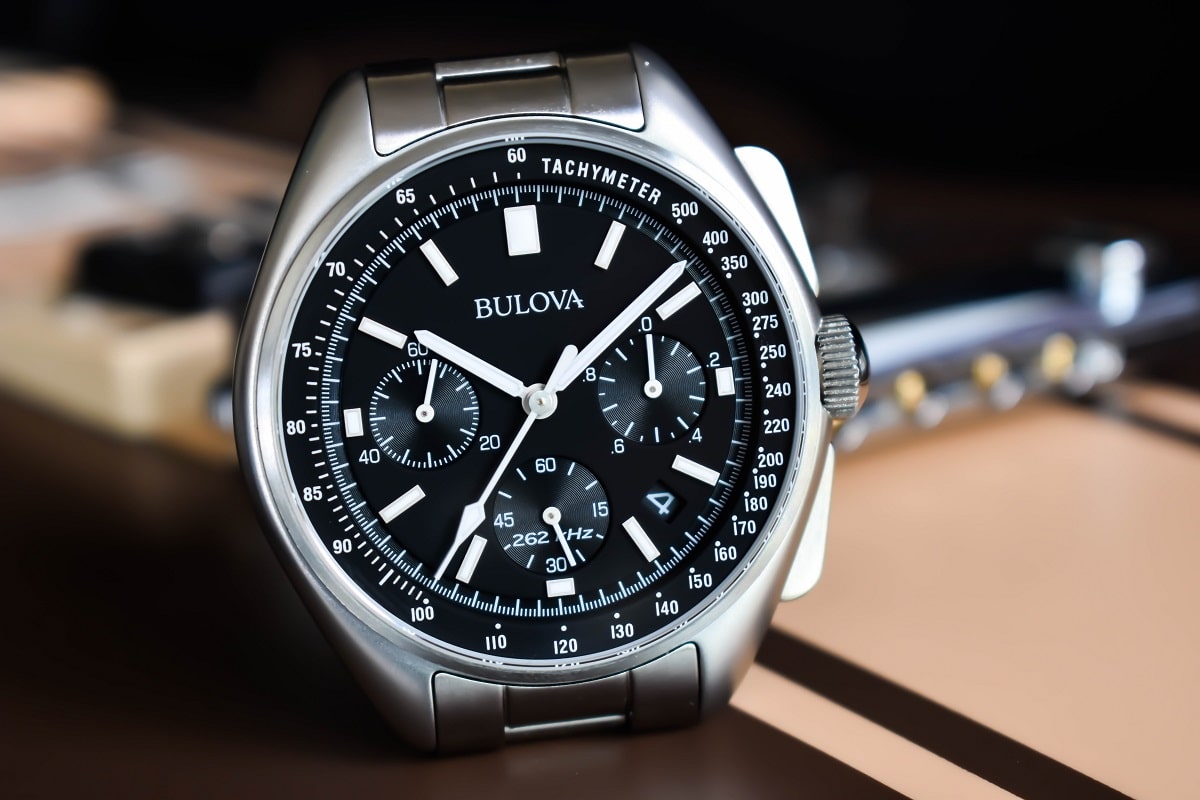
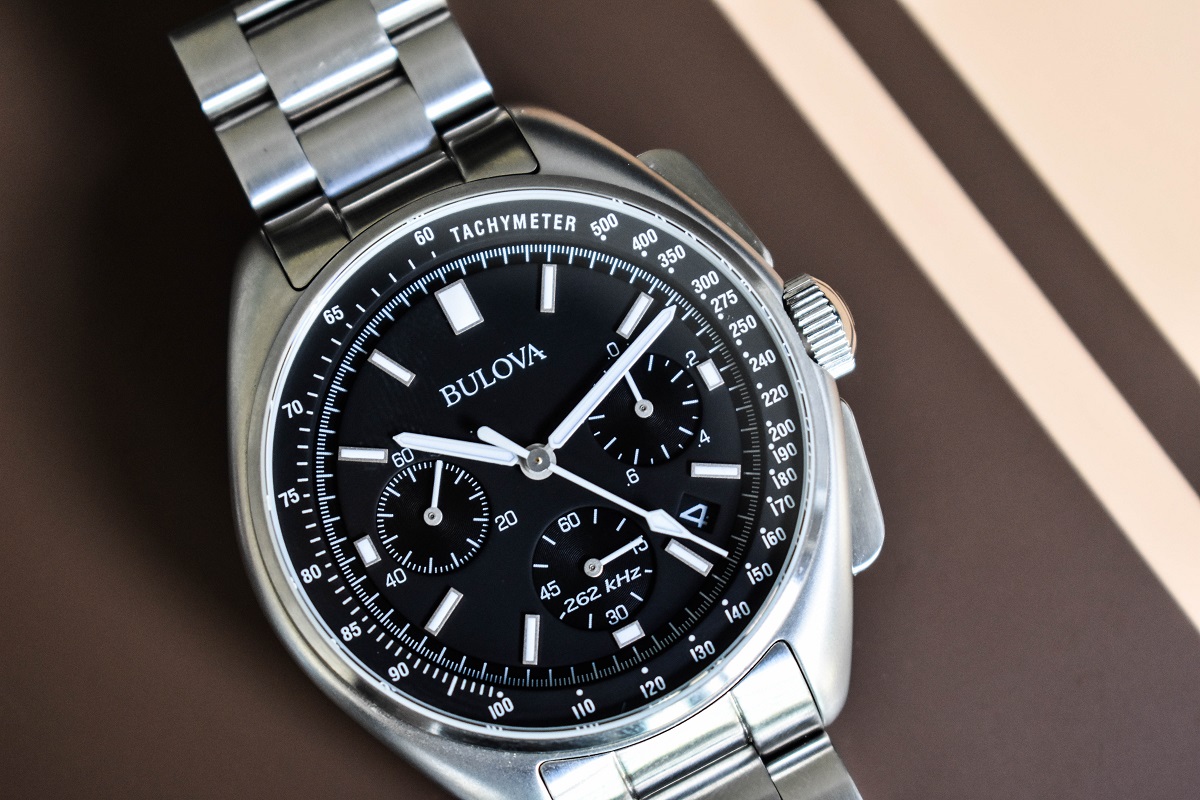
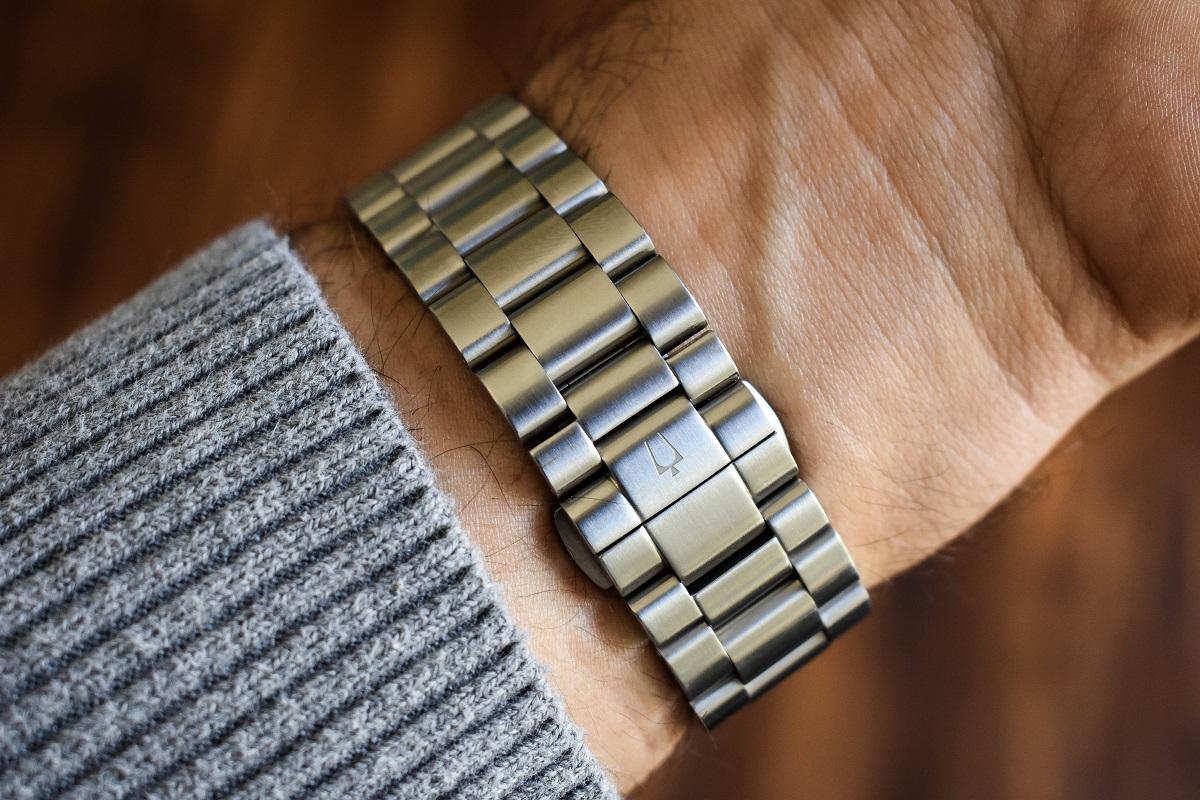

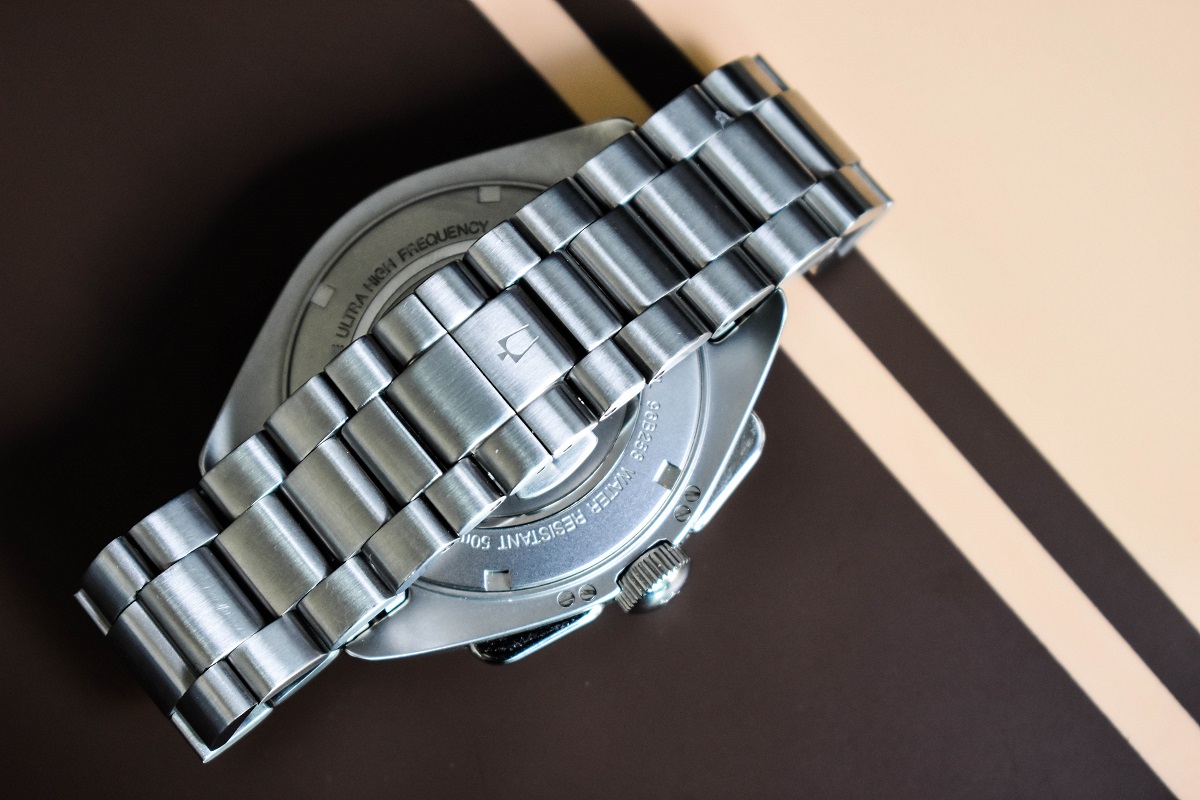
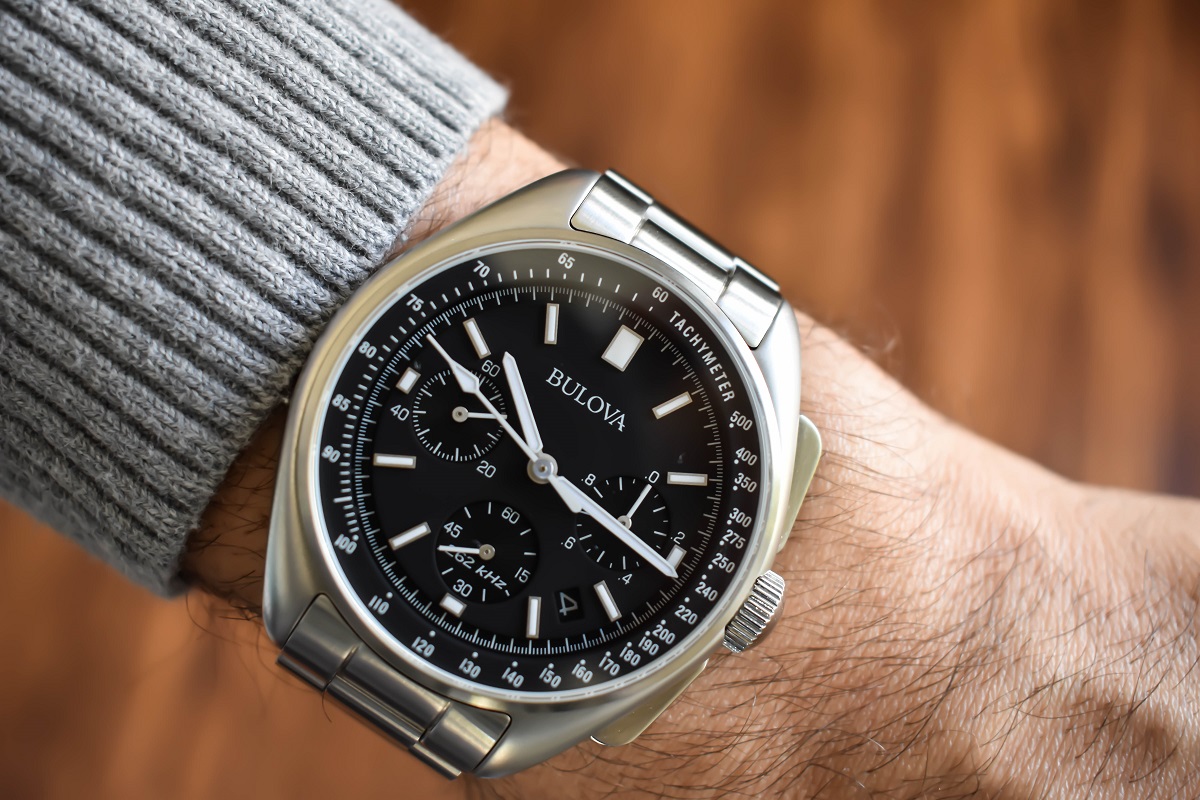
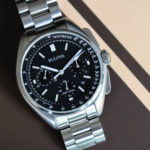
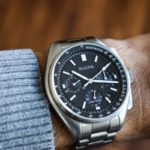
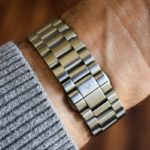
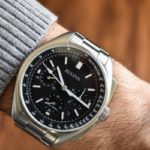
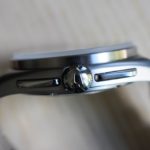
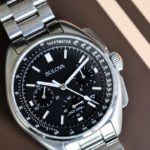
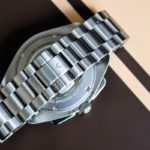
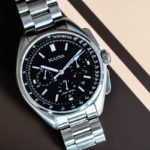
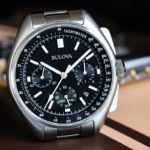
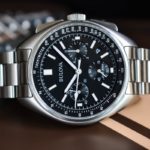
Always wondered why you sold it Michael. When I bought mine I went with the two-strap version, and for me the Velcro two-piece NATO makes this watch. I can’t compare it to the bracelet since I don’t have one, but the Velcro strap allows for a nice wrist hugging fit, and the addition of the Apollo 15 mission date and UHF frequency on the tail is a really nice touch that just adds to the tool watch feel. If you do decide to pull the trigger on the Gen II, I’d highly recommend trying to source the Velcro strap.
As far as the black vs. blasted SS case, I’ve also read that it “wears smaller” because of the color. Personally I’ve never felt that black cases wear any smaller than non-coated cases, so I’ll be interested in your thoughts on that point.
Cheers bro.
-Eric
Why is a non-tapered bracelet ‘hilarious’? I always think tapered bracelets look odd.
Good question. Well, for me on a watch this large a bracelet that doesn’t taper just makes it appear more like a steel cuff than a watch. There’s a reduction in visual interest and from a comfort standpoint, I want less metal covering the surface area on the underside of my wrist. Your mileage may vary, of course, but to me this made it feel as if Bulova dug the bracelet out of a parts bin, which is unfortunate because it’s actually of a very good quality. However, I don’t feel that it compares to the well thought out case architecture we see here.
Having had my bracelet version for the past year and a half I couldn’t be happier. I’d saved for my grail watch, an omega speedmaster pro, and discovered that it didn’t fit the broad top of my wrist (8.5” wrist, which I think is irrelevant as the main issue is if the plain of your wrist is wide enough for the lug to lug) and, after trying a Pogue, tried out the Bulova. The bracelet does match the collar of the bezel under the crystal,and the pushers. I find it bothersome that the bracelet isn’t interchangeable unless you have a set of curved pins, that strikes me as a cash grab, and I did end up buying the strap version as well. I think, and this is only my opinion, that this watch is superior in most respects to the Omega in accuracy and in dial design. Great review, like to hear others viewpoints.
You might have considered the leatherbracelet or put one a replacement metal or leatherbracelet you like better on yourself. Just a thought. The standard bracelet does look a bit massive as does the bracelet on the seiko sna411p1 pilotwatch but some get used to it and some don’t.
Wouldn’t exactly claim that they dug it from the parts bin since for sure they gave it a lot of thought what to put on their less famous than the omega moonwatch and very friendly priced latest bestseller.
Personally I think they could have left the date out as with the black version but with a stainless steel casing to contain the timepiece maybe in a 42mm version.
Agreed. Omega enthusiasts say the same thing. I love the straight lines of the non tapered bracelet and most of is it hidden under the wrist anyway. Nit picking.
I have the bracelet model and it’s absolutely awesome. The watch might be 45mm, but that’s case to case. The dial is more like 41mm.
The bracelet is beautiful. 20mm is the right size. I wouldn’t want it tapered, which never looks good. I’ve had the watch for well over a year and it still looks new…and it’s been my daily.
I owned a Speedmaster Professional for over 20 years, and this Bulova is just as satisfying. The 262 kHz movement is spectacular. I can’t begin to tell you how wonderfully accurate it is. So nice knowing that it basically never gains or loses time. Having owned a Rolex chronometer and the Speedmaster, I grew tired of wild variances in timekeeping.
If I were to make changes, I’d make it smaller, perhaps put a domed crystal, change the logo lettering, put more writing below the Bulova name…and that’s about it. Without a doubt one of the greatest watch values out there…along with the Orient Classic Power Reserve Automatic.
BTW Michael…a terrific review…and beautifully photographed.
Reading your article now and I really want to get my hands on one. Thank you!
I picked up a new Lunar Pilot back in spring 2019 from a small independent watch shop as well. Mine is the brushed case, dual band (nato and leather) version. He had it on display for a while and I was able to get it cheaper than Amazon… AND talked him into the half moon dealer stand (with box).
I didn’t like the leather band, and just couldn’t come to like it on the nato band. I found a nice, thick, chunky, black leather band for it and it looks great. I hardly wear it and will hand it down to my little boy.
BTW…apparently there were a couple versions made, other than color. Has to do with the markings on the case back.
Dying to own one of these but at 45mm it’s just too darn big. Why Bulova, why?
I am constantly looking for excuses to purchase one of your watches but they are either too big or too garish.
They really are stunning things and amazing value. That the crystal sits high of the case (why?) is the only sub optimal thing about it.
Great review! We’ll thought out. I’m an actually NASA spacecraft engineer, but thought I’d go to my grave without a Speedy Moonwatch… Then along came this Big Bad Boy! Life patience pays off and I just got one for this Father’s Day. It’s everything I hoped for, and then some, including the story! My seven inch wrist just gets this things too home plate for the score. As an engineer I can’t say enough about the engineering in this movement – like NASA, it really is the tops! A REAL mooon watch, attainable for the average guy! Don’t hesitate, just get it.
The original (both the Speedmaster and the Bulova) were large watches- they weren’t meant to be fashion statements and in typical government contract fashion were over engineered. Bulova made a watch specifically for contract, Omega submitted an existing watch that just happened to meet the specs. Historically, Omega is more accurate as the ‘Moon’ watch, and Bulova’s re-release is ‘what might have been’ with some modernized fashion updates. I really like the original dial on Dave Scott’s watch but he literally had the only one in existence as a prototype, so this version is the best we get.
Funnily enough, another one (sterile dial) went to an auction I think just before the new Bulova version. At the time, nobody new what it was, but when the Lunar Pilot came ut, a horological journalist recalled the sale and dug out the auction catalogue. So there must have been at least one other prototype – the case and pusher design is unique. Always wondered since if the buyer realised afterwards what they had picked up!
They are releasing a 43mm version no date!
Sorry but this model nothing like the real watch ? i dont get it ? why make a ” homage ” to the only “other ” watch ever worn on the moon that looks nothing like the actual original watch – why not make it 39mm with a manual winding mechanism, and reproduce the dial faithfully without the date etc i.e a real reissue would sell millions – this is nothing like the 1971 watch . i dont get it sorry – its not the watch that went to the moon inside scotts back pocket . i can buy a parnis with a manual wind chronograph movement for less that $100 – the point isnt the mechanism its the history and this is not that watch . They just have not reissued the original watch – its pointless .how many speedmasters would Omega be selling if they were massive like this with a quartz movement inside for $500 – i will tell you …none !
Michael .. What size is your wrist? Just trying to gauge the size. Thanks!
@Andrew Price:
You totally missed the reason for this watch. Bulova was the primary clock provider for the Apollo instrumentation and it also manufactured the clocks that were included in many of the lunar experiment packages. It was deeply involved in the Apollo program, just not on the wrists of the astronauts themselves.
The “prototype” chronograph is a very small and until recently unknown portion of the Bulova’s moon legacy.
Once the original Dave Scott prototype sold for what it did, Bulova realized they had the ability to issue a watch that simultaneously acknowledges their past while honoring the leading edge technology that they were known for.
The reason that Bulova didn’t have a mechanical contender for the space program was they were basically all in for the accutron tuning fork movement.
The prototype was actually created by a Swiss company Bulova had purchased specifically to take the contract from Omega. They were going to give the watches to NASA free of charge, but NASA had already paid Omega for the watches and were not in the market for more and had no interest to change horses mid stream..
I think this watch does a great job by honoring the look and feel of the original prototype, while incorporating leading edge technology by incorporating the High Frequency movement. If they had settled on a simple +/- 15 second quartz movement, I’d agree with your critical assessment.
But a +/- 10 second annual accuracy is something that can only be bested by watches costing much more.
I love your comment, William. I have a tuning fork Bulova and love it, I don’t know why they didnt just go with that at the time. Historically you are on point as well. Its fun baiting Omega people sometimes with the notion that while Omegas were a contracted watch for the Apollo landings, Bulova has a much stronger legacy with the US Space program than Omega does, and went to the Moon just as often, just in a different iteration (the instrument panel timers).
Late reply I know. In answer to your question, NASA did not trust “battery powered” watches for the astronauts. Battery technology was not what it is now, and they thought the batteries would not withstand the extreme temperature variations in space and on the moon.
NASA didn’t even trust “automatic” mechanicals because the winding of automatics rely on gravity.
So NASA decided to go with only simple hand wound watches as candidates, and Bulova simply didn’t have one.
This proved to be a fortunate choice as the “hand wound” Omega’s were the only thing aboard Apollo 13 that allowed them to get back to earth. The cabin Bulova’s were dead as well as every other instrument in the adrift spacecraft.
They later pressured NASA (with congressional help) to reopen the bidding process for Skylab and Shuttle missions. The “prototype” Scott brought with him was supposedly given to him so they could get some real life testing done.
Unfortunately, despite Bulova’s protests about Swiss maker Omega, the Omega actually had more “Made in USA” components in it since Omega subcontracted several US companies to make components for the Speedmaster. The only thing Made in USA component on the Bulova prototype was it’s name.
Great story about the whole “sorrid affair” in a Worn and Wound web article (https://wornandwound.com/bulova-used-universal-geneve-get-moon-can-get-one-today/) which makes this particualar watch even more compelling.
Of course it’s now common knowledge that self winding watches do work in space. An acceleration of the watch during wear creates a resultant force even in a weightless environment.
“…how many speedmasters would Omega be selling if they were massive like this with a quartz movement inside for $500 – i will tell you …none !”
Yeah, that didn’t age well.
How many MoonSwatches DID Omega/Swatch sell which had cheap quartz movements in them, cheap plastic cases which bled color onto your wrist, plastic (not hesalite) crystals, and cheap stickers for the “bezel insert”?
And how many of those MoonSwatches sold well above $500.00 in the secondary market?
Yeah….
I’ve read that the bracelet will not fit the original nato band case so you have to buy the bracelet version if you want one and could go nato later but not the other way around.
Can anyone shed light on this?
Thanks!
It’s the drillings, they are different for the different versions. Supposedly curved spring bars will get you round.
The model that comes with the metal bracelet has the lug holes in a differential location relative to the watch head. No one seems to know why Bulova did it this way. You can put a leather/Velcro strap in the bracelet model but the stock metal bracelet won’t fit on the non-bracelet model.
Not sure about this, but perhaps the difference in finishing of the braclet and case is because a sand blasted surface on the bracelet would eventually become polished in wear making it look bad.
I purchased the version with the leather strap and NATO strap. I sold mine mostly because I didn’t like the strap, although it was a bit on the big side. I am currently looking to purchase the version with the bracelet, so I appreciate your insight in that department.
I found the watch to be great looking and, of course, super accurate.
I must be living in a cave because I never knew this 2 of 2 moon Watch existed. Poor Bulova, omega taking all their steam. They really should amp up their moon watch advertising. I like the limited edition titanium and gold version but the gold is just too shiny so I opted for the standard version. For me 44/45mm is the sweet spot. My 42mm omega speedmaster is the smallest in my collection but hey now I’ll have both official moon watches (and 1 plastic MoonSwatch)